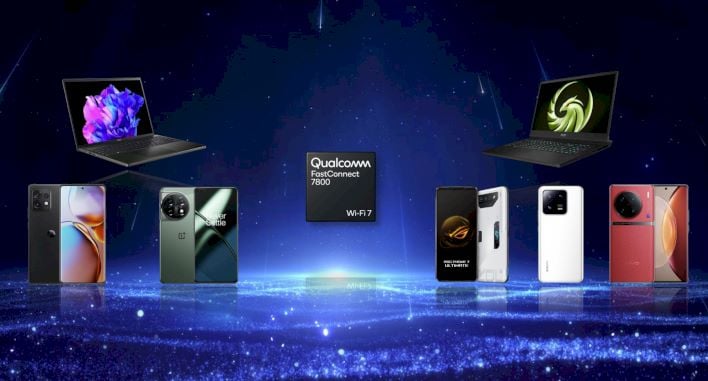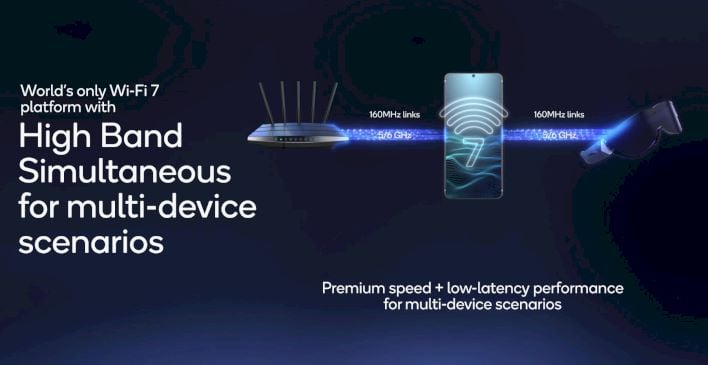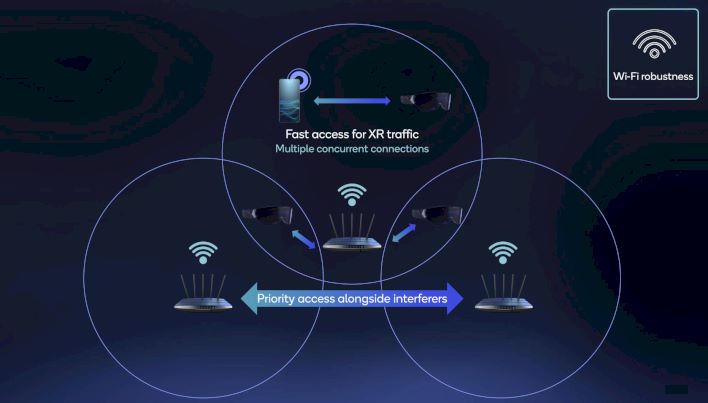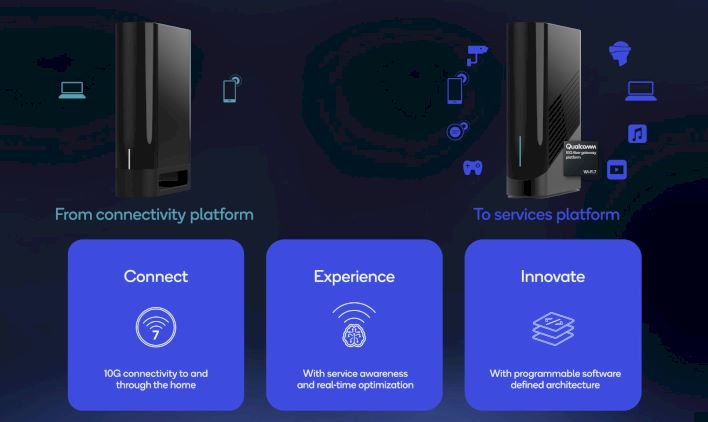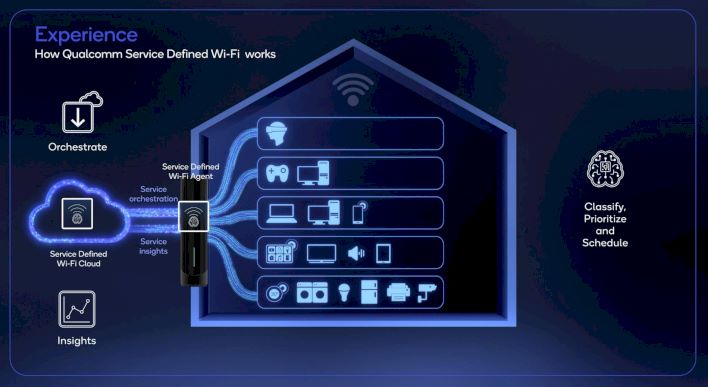Qualcomm Wi-Fi 7 Advances Boost Performance And Introduce Key Software Optimizations
Wi-Fi 7 Unlocks New User Experiences
We’ve covered the benefits of Wi-Fi 7 before, but it is well worth reiterating here. Wi-Fi 7 brings a prescriptive doubling of throughput and expands usage of the 6GHz band introduced with Wi-Fi 6E, largely thanks to doubling the channel width from 160MHz to 320MHz. That channel width is only possible because of the 6GHz spectrum, though that’s where Wi-Fi 7’s next trick comes in, known as Multi-Link Operation (MLO).
Qualcomm’s High Band Simultaneous (HBS) multi-link allows the router and client device to use multiple channels at once, even across bands, in aggregation to improve throughput. This means that 320MHz channel width does not need to come from a single channel. Instead, it can aggregate, for example, a 160MHz 5GHz channel and a 160MHz 6GHz channel together to achieve the 320MHz performance. Doing so also significantly reduces latency and helps avoid interference which wider channels are more prone to.
Qualcomm introduced its FastConnect 7800 Wi-Fi 7 solution last year, which was the first commercial Wi-Fi 7 platform available in the industry. It can push speeds of up to 5.8 Gbps with sustained latency as low as two milliseconds. The FastConnect Software Suite works in tandem to provide end-to-end improvements that include lower latency, better power efficiency, and signal reliability that Qualcomm says truly rivals, or even exceeds, the typical wired Ethernet experience for the first time.
Starting with battery life and power usage, the FastConnect Software Suite rapid power collapse and restore modes shifts from a consistent exchange of packets to data bursts. The devices are able to apply power savings modes between the bursts, which reduces the overall power of the wireless subsystem by more than 25 percent.
The FastConnect software suite reduces latency by over 80% compared with when the software suite is not used. Qualcomm isn’t talking about average latency, either, but 99-percentile latency. It also reduces peak latency by a substantial amount. Even a single spike of 100 milliseconds can deteriorate the experience of an application, and this is becoming increasingly important with the rise of streaming XR headsets and other high-bandwidth, real-time use cases.
All of this only works if interference is effectively managed, however. The number of devices in use per home is growing rapidly, particularly as IoT devices gain popularity. The FastConnect Software Suite achieves better signal robustness and reliability through intelligent channel selection and spectrum reuse.
Wi-Fi 7 unlocks new user experiences through all these advantages. The flashiest use case is probably untethered XR headsets, and that’s a big angle that Qualcomm is pushing, but you that’s not the only place it will be felt. The latency and signal reliability factors are also very important for gaming, particularly when you cannot always run an Ethernet cable to your PC or console. It can also make game streaming, either in-home via something like Steam or online through GeForce Experience, much more responsive.
The Rise Of Service Defined Wi-Fi
Whatever your use cases may be, every one of our home networks is unique. Whether you look at the collection of devices connected to it or the applications being used, managing the user experience can be challenging. Wi-Fi 7 is better suited to handle modern congested environments, but doesn’t solve the problem on its own. Other tools like band steering to dynamically allocate channels, mesh networks to expand coverage, or Wi-Fi Multimedia (WMM) to provide some QoS service classes can also be improved upon.Qualcomm, perhaps correctly, believes that the Internet experience stops and starts with Wi-Fi for most home users. The question is then, does the wireless experience meet expectations? It isn’t so much a matter of what the size of the data pipe coming into the home is if things are not configured optimally and the actual broadband connection isn't being fully leveraged.
Part of the challenge is that the optimal configuration evolves constantly depending on the applications being used. You may have a VoIP line to take a call that’s getting broken up by someone else’s download elsewhere on the network, whatever the case may be.
Qualcomm’s proposal in Service Defined Wi-Fi is to allow service providers to go beyond offering speeds and feeds, and allow them insight into the connected devices and services being used so the network can be better tailored to the end user’s expectations. The user may just sign up for a “gaming package” or a “work from home package” and as long as it works, that may be all they care about.
This takes the form of a service defined wi-fi agent residing on the customer’s gateway. This is provisioned remotely by the ISP, but performs its classifications, prioritizations, and scheduling locally. It provides far more service classes for prioritization than the four WMM provides, with no real limit. It isn’t a set it and forget it situation, though. The solution incorporates telemetry and analytics which can feed back into policy updates or prompt other improvements.
The software stack is fully programmable with open APIs on a cloud native framework and hardware backing. In fact, it is fairly hardware agnostic. While it supports the latest Wi-Fi 7 has to offer within a network, it works across Ethernet and even older Wi-Fi generations as well, so no client is left behind.
From the ISP’s perspective, this allows companies to generate better feedback on an individualized basis to improve service. It also provides opportunities to perform proactive troubleshooting based on how applications are performing at runtime, which could result in having to field fewer customer support calls.
Keeping Up With Wi-Fi 7 Speeds
As Wi-Fi 7 ushers us firmly into the multi-gigabit era, our broadband Internet connections are having a difficult time keeping up. Qualcomm’s 10G Fiber platform can do just that, though. It is a multi-function device to serve as your 10G-PON (Passive Optical Network) gateway and also integrates a Wi-Fi 7 access point to deliver what Qualcomm says is the best user experience.On the Wi-Fi 7 side, it supports simultaneous operation across the 2.4GHz, 5GHz, and 6GHz bands with full support for 320MHz channels and 4K QAM to deliver peak aggregate bandwidths of up to 33Gbps. Of course, it also supports all the Qualcomm Service Defined Wi-Fi features outlined above.
Still, not everyone has access to a fiber line. In these cases, Qualcomm introduced its 5G Fixed Wireless Access (FWA) Platform Gen 3 earlier this year. This includes both mmWave and Sub-6 GHz bands to connect homes where fiber is infeasible to install.
Although Wi-Fi is essentially ubiquitous now, an much faster and more reliable than ever before, its evolution continues unabated. Wi-Fi 7 will deliver increased speeds, lower latency, and superior handling of multiple devices on crowded networks. All of these are important factors to continue pushing the envelope and to enable advanced wireless experiences. It may take some time for Wi-Fi 7 to fully ramp and have a meaningful impact on the wireless landscape at large, but Qualcomm’s innovations appear to be setting the stage for significant improvements in bandwidth, latency and reliability, even at this early point in the lifecycle.

